About Us
Division of Natural History
Library
The Division of Natural History has a collection of a wide variety of literature including academic journals and books on ornithology from Japan and overseas. The library now holds a collection of 70,000 items, which is the largest ornithology library collection in Japan. The core of the collection consists of the literature collected by the founder Yoshimaro Yamashina and those donated by other ornithologists, etc. The collection is being further expanded by purchases, exchanges, and donations. The collection includes foreign academic books that in Japan one can only find at the institute, and rare and precious books, such as monographs of hand-colored lithograph, that are extremely hard to come by now.
The Division of Natural History is aspired to further expand its collection so as to contribute to the development of ornithological studies in Japan, and provides opportunities for researchers to utilize the collection.
>> Guide for using the library

The largest ornithology library in Japan
The Library Collection at the Institute
Much of the collection are based on the literature collected by the Yamshina Yoshimaro and those donated by ornithologists, such as Drs Takatsukasa Nobusuke and Kuroda Nagamichi, and by the general public. The institute also collects specialized publications in such fields as taxonomy, ecology, and so on, and journals published by Japanese and foreign academic associations and museums, through purchasing, donation or in exchange with the Journal of the Yamashina Institute for Ornithology.
Collection of periodicals at the Institute
The Division of Natural History currently holds a collection of approximately 2400 titles of periodicals. Most of these are academic journals on birds, but also includes numerous newsletters published by local bird watching or bird conservation groups in Japan.
Book Collection at the Institute
The collection at the institute includes approximately 11,000 books. Most of these books are specialized books, monographs and field guides, but the collection also includes a variety of books on birds including those on nature conservation or art.
Management and Use of the Library
The Division of Natural History, as the specialized library on ornithology, is aspired to collect all kinds of printed and other related materials on birds and to build a management system which ensures effective utilization of the collection. Currently the closed stack system of the library prevents people to go in and browse the books freely, but we try to make it convenient for researchers by responding to individual requests. The institute will strive to ensure that the library will contribute to the works by researchers and to people who are interested in living things and nature. (Please click here for the guide for using the library)
Rare Books at the Institute
The institute's collection includes about 100 monographs of hand-colored lithographs and copper engravings which were published in Europe in the 19th and the beginning of the 20th century. The beginning of the 19th century is said to be the golden time of the natural history, and many monographs of animals and plants were published. However, hand-colored lithographs were very expensive at the time as they required enormous effort and skills to create, and they were only printed in limited numbers, ie. several hundreds. Currently much of these monographs have been destroyed due to wars and disasters. In this respect, the collection at the institute can be considered a precious cultural heritage. These books are not only valuable from the view of ornithology but are also important evidence for understanding how natural history was practiced when printing technology was still premature. These are important materials for studying the history and the progress of natural history. They are also highly valuable from the standpoint of art and bookbinding techniques. Passing these precious books to the next generation is also an important role of the institute.
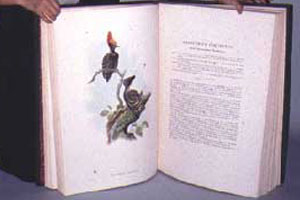
Valuable pictorial books published in the 19th century can be found at the institute(An ornithological monograph by John Gould, a British ornithologist)
Specimen Collection
The avian specimen collection at the Yamashina Institute for Ornithology includes 80,000 items such as skin specimens, skeletons, nests, eggs, and fluid preserved specimens. The largest collection in terms of numbers is the study skin specimen collection.
The collection consists of the specimens collected by the founder Yamashina Yoshimaro and Japan's leading ornithologists, as well as those that were purchased or obtained in exchange. The collection is still expanding by preparing specimens mainly from dead birds received at the institute. The specimen collection covers major species from all over the world and the collection of East Asia and the Pacific is one of the largest in the world. The collection includes academically valuable specimens, including specimens of extinct and rare species, and type specimens which were used in describing new species and subspecies.
The specimens are being kept organized for improved usability, and are being utilized by researchers. We respond to inquiries from research institutions in and outside of Japan.
>> Guide to using the specimen collection
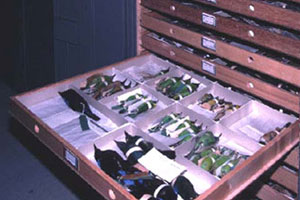
The collection room, one of the largest bird specimen collections in East Asia
Collection and Management of the Specimens
In the past ornithologists shot birds and prepared specimens, but nowadays most specimens are prepared from road kills, birds died in veterinary hospitals and are carried into the institute, and other dead birds. First, the dead birds received are numbered and information such as the dates and places found and the carry-in route are recorded. They are then dissected and checked for sex and age, and are turned into specimens of different types depending on the condition. Some that cannot be processed in-house are outsourced. The completed specimens are labeled, which includes such information as the accession number, species name, sex, age, locality and date of collection, etc, and are stored in cabinets. The collection room is kept at a constant temperature and humidity and the cabinets are treated with insect repellent. The specimen room does not have windows so as to prevent discoloration by UV light.
The specimens can be preserved almost permanently if managed well. Some of the specimens at the institute are more than 100 years old. Access to the specimen room is kept to minimum to prevent molding, etc. For this reason, the room is open to researchers only on request basis and the general public is not permitted in the room.
What are study skin specimens?
When one hears the word "stuffed specimens" one might imagine mounted specimens often found in museums, perching on trees. These specimens are mostly used for display and educational purposes. Mounted specimens help to know what the bird looks like, but they take space in the storage and are not suited for measuring or for comparing different specimens. Thus there are stuffed specimens prepared especially for research purposes; study skins. Study skins are made by first removing internal organs, muscles and bones, coating it with chemicals and then finally stuffing with cottons. They are shaped as if the birds are lying down on the backs. They can be created relatively easily and do not require much space in storage. Most of the specimens at the institute are these study skins. Others are mounted specimens and specimens of eggs, internal organs, nests and skeletons.
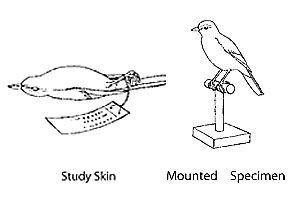
Using the Specimens
The specimens are used by researchers of many fields. They use specimens to study taxonomy by comparing the external morphology or to identify birds in the fields. Yamashina Institute for Ornithology is the only institute in Japan that has avian specimen collection of such size, and is visited by many researchers every year for studying these valuable specimens.
Maintaining the Specimens
It is normal for birds of the same species to have different coloration and morphology, depending on sex, age or region. Thus studying birds require collecting many specimens. Currently the institute has as many as 80,000 items of specimens. These enormous amount of specimens need to be maintained in an organized manner in order for them to be fully utilized for research. For this reason the specimens are organized in taxonomic order. Furthermore, the institute disclosed an online specimen database on the internet in 2009.
Specimens of Extinct and Rare Species
The Yamashina Institute for Ornithology has a collection of specimens of extinct species including the Passenger Pigeon Ectopistes migratorius and the Carolina Parakeet Conuropsis carolinensis, the most frequently introduced extinct birds that once existed in North America. These bird species are already extinct from the earth, and thus specimens of these species cannot be obtained again and thus are invaluable. There are also specimens of rare species threatened with extinction, including the Nordmann's Greenshank Tringa guttifer that breeds in Sakhalin and the Okinawa Woodpecker Sapheopipo noguchii, found in forests of Okinawa Islands. As these birds cannot be collected again the values of the existing specimens are extremely high from the research standpoint.
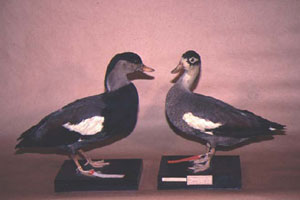
Specimens of the Crested Shelduck Tadorna cristata, one of the rarest specimens in the world
What are Type Specimens?
When a new species is found and named by a taxonomist, he must designate a specimen he used as the holotype specimen. This minimizes confusion of names when the original taxonomy is doubted or revised by a later research. It is recommended by "International Code of Zoological Nomenclature", an international agreement among zoologists, that museums and research institutions take responsibilities in managing the type specimens.
The Yamashina Institute for Ornithology has type specimens of species such as the Okinawa Rail Gallirallus okinawae, the Stejneger's Petrel Pterodroma longirostris, and a couple of dozens of subspecies. These type species are the references for bird taxonomy and are common property of the science world.
Ecological Research of Sea Birds
- Understanding foraging and breeding ecology of the Streaked Shearwater Calonectris leucomelas -
In order to protect threatened bird species and their environment, it is particularly important to collect biological information on birds that have major impacts on the habitat area and have similar habits.
The institute is conducting a joint research with Hokkaido University and the University of Tokyo to study how the Streaked Shearwater Calonectris leucomelas, most of which breed on Japanese islands, utilize the local characteristics of the surrounding oceanic environment for their breeding. We are studying breeding populations found on different islands with significantly different oceanographic structures, and are comparing their fitness by measuring basic ecological parameters such as breeding ecology, foraging behavior on the sea, nutrient levels and changes in stress hormone secretion.
The results of these analyses will be used to identify information necessary for recovering rare seabirds belonging to the same taxonomic group such as albatrosses.
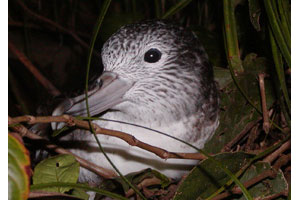
DNA Research of Endangered Birds
Endangered birds with limited population size generally tend to have less genetic diversity. For that reason, they are likely to have less resistance against diseases or environmental changes. However, such information on Japanese endangered birds is limited. With the help of Japan Water Agency and Hyogo College of Medicine, the institute is sequencing DNA from blood and feather samples of endangered bird species. We will use the data to identify genetic diversity in order to reveal the stumbling block that is hindering recovery of endangered species.

DNA barcoding
Birds are one of the animal groups whose taxonomy is the most studied. However, identification of species is sometimes difficult. Identification of species with similar forms, juveniles or identification from limited parts of the body can often be difficult even for specialists. "DNA barcoding" becomes useful in such situations. This technology enables easy identification of species using a specific DNA sequence and reference specimens. Currently, approximately 10,000 species of birds are being analyzed by research institutions worldwide. The Yamashina Institute for Ornithology is collaborating with the National Museum of Nature and Science to analyze all bird species in Japan.

Specimen Database
The Yamashina Institute for Ornithology (YIO) possesses approximately 80,000 bird specimens -the greatest number in Japan- and includes skins, spread wings, skeletal specimens, spirit specimens, eggs, and nests. Since 2001, the YIO has been supported by the Japanese Ministry of Education, Culture, Sports, Science, and Technology; the funds provided by the Ministry have been used to order, label, and photograph the specimens, as well as to record specimen descriptions. The specimen database was made available to the public online on December 28, 2009; at that time, the database contained mainly information on bird skins.
Guide to Using Specimens and Library Collections
Please refer the page about 'Guide to Using Specimens and Library Collections.'

